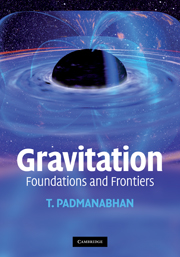Book contents
- Frontmatter
- Contents
- List of exercises
- List of projects
- Preface
- How to use this book
- 1 Special relativity
- 2 Scalar and electromagnetic fields in special relativity
- 3 Gravity and spacetime geometry: the inescapable connection
- 4 Metric tensor, geodesics and covariant derivative
- 5 Curvature of spacetime
- 6 Einstein's field equations and gravitational dynamics
- 7 Spherically symmetric geometry
- 8 Black holes
- 9 Gravitational waves
- 10 Relativistic cosmology
- 11 Differential forms and exterior calculus
- 12 Hamiltonian structure of general relativity
- 13 Evolution of cosmological perturbations
- 14 Quantum field theory in curved spacetime
- 15 Gravity in higher and lower dimensions
- 16 Gravity as an emergent phenomenon
- Notes
- Index
4 - Metric tensor, geodesics and covariant derivative
Published online by Cambridge University Press: 05 June 2012
- Frontmatter
- Contents
- List of exercises
- List of projects
- Preface
- How to use this book
- 1 Special relativity
- 2 Scalar and electromagnetic fields in special relativity
- 3 Gravity and spacetime geometry: the inescapable connection
- 4 Metric tensor, geodesics and covariant derivative
- 5 Curvature of spacetime
- 6 Einstein's field equations and gravitational dynamics
- 7 Spherically symmetric geometry
- 8 Black holes
- 9 Gravitational waves
- 10 Relativistic cosmology
- 11 Differential forms and exterior calculus
- 12 Hamiltonian structure of general relativity
- 13 Evolution of cosmological perturbations
- 14 Quantum field theory in curved spacetime
- 15 Gravity in higher and lower dimensions
- 16 Gravity as an emergent phenomenon
- Notes
- Index
Summary
Introduction
We begin our study of general relativity and curved spacetime in this chapter. Chapters 4 and 5 will develop the necessary mathematical apparatus to deal with curved spacetime. As in the case of electromagnetism, the study of gravity can be divided into two separate – but interconnected – aspects. In this chapter and the next, we will study the influence of gravity on other physical systems (like particles, photons, ideal fluids, fields, etc.) without worrying about how a given gravitational field is generated – which will be discussed in Chapter 6.
All the topics introduced in this chapter will be required in the subsequent chapters and form core material for general relativity. In particular, we will start introducing index-free vector notation more liberally in the coming chapters and familiarity with the ideas and notation developed in Section 4.6.1 will be crucial. We will use units with c = 1 unless otherwise indicated.
Metric tensor and gravity
The arguments presented in the previous chapter suggest that a weak gravitational field cannot be distinguished from a modified spacetime interval as far as mechanical phenomena are concerned. We shall now generalize this result by postulating that all aspects of gravitational fields allow a geometrical description. We thus extend the tentative conclusion of the previous chapter to include arbitrarily strong gravitational fields and all physical phenomena. This leads to Einstein's theory of gravitation, which is the most beautiful of all existing physical theories.
- Type
- Chapter
- Information
- GravitationFoundations and Frontiers, pp. 136 - 188Publisher: Cambridge University PressPrint publication year: 2010



